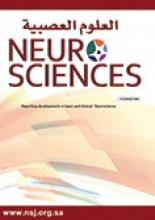Abstract
Authors describe clinical features, CT scan and MRI findings of 4 Egyptian boys (3 brothers from one sibship and a sporadic case) with Hallervorden-Spatz syndrome (HSS). These patients presented around the age of 10-years-old with rigidity, dystonia, dysarthria, mental deterioration with loss of previously acquired skills and choreoathetotic movements. The 3 brothers developed seizures around the age of 16 and the older brother died at the age of 20. Although, the CT scan of the 3 brothers showed bilateral symmetrical calcification of the basal ganglia, the MRI of the 4 cases demonstrated bilateral symmetrical hyperintense areas surrounded by hypointense areas in the globus pallidus giving the characteristic “eye-of-the-tiger” sign. Based on the clinical and MRI picture, these 4 cases could be the atypical type of HSS. However, calcification of globus pallidus is an associated finding in these cases. This is the second report in the literature with this association. In addition, we present the results of the use of antioxidants, L-dopa and Botulinum toxin injections in the management of these cases.
- Copyright: © Neurosciences
Neurosciences is an Open Access journal and articles published are distributed under the terms of the Creative Commons Attribution-NonCommercial License (CC BY-NC). Readers may copy, distribute, and display the work for non-commercial purposes with the proper citation of the original work.






